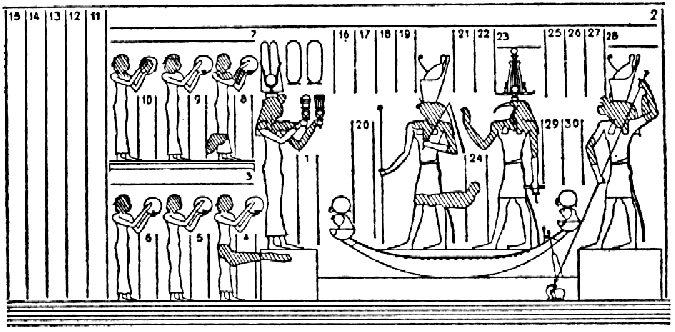
| queen shaking sistra|
N.B., column numbers in the drawing reflect verse numbers in Fairman's transcription of the text.

In this scene, the god Horus and the Egyptian king are now fully assimilated into one being. For that reason, the king does not appear.Description: In the first part of the scene, Horus of Behdet stands beside the sacred lake on a podium at the right (i.e., stage left). He wears the usual nemes-headdress but not the Double Crown (despite that he is shown wearing the crown in the scene), and he mimes the slaying of the now-dead hippopotamus with a large harpoon. Thereafter, he boards his sacred boat at center stage for his coronation ceremony. The prow and stern-posts of the ship are surmounted with effigies of the falcon head of Horus with sun disk. Horus is accompanied on board by the god Thoth who wear the nemes headdress and the Hemhem-Crown. In the ceremony, Thoth invests Horus with the royal insignia of Egypt, i.e., a gold scepter in the form of a flail or whip and a gold scepter in the form of a short crook, which the god-king holds in crossed hands over his breast. During the investiture, the chorus sings the praises of Horus the King. Then, Thoth--in all pomp and splendor--crowns Horus with the red and white Double Crown of Upper and Lower Egypt. Horus replies to the chorus confirming his royal status.
The Queen-mother, Cleopatra III, stands on a podium on the left (i.e., stage right), and shakes two sistra while lauding the king's victory over Seth (the sistra are jingly rattles sacred to the goddess Hathor). On the north side of the sacred lake stand "Princesses of Lower Egypt," while on the south side are "Princesses of Upper Egypt." In praise of Horus, they chant three times in alternate stanzas, first the Lower Egyptians, then the Upper Egyptians, while beating tamborines in time to their chants. They are joined in their rejoicings by the Queen and by Women of the city of Busiris and Women of the towns of Pe and Dep (not depicted).
| Return to Scenes and Details-page |